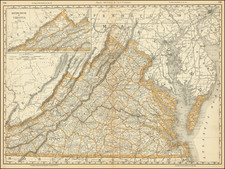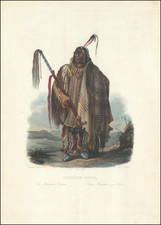Idolum Kiwasa XXI, engraved by Theodor De Bry and published in Frankfurt in 1591, depicts the Kiwasa idol of Secota, associated with overseeing the dead in its temple. This is an original engraving from De Bry's Grands Voyages series.
During the late 16th century, European explorers were documenting their encounters with previously unknown regions and their inhabitants. Theodor De Bry's Grands Voyages sought to compile these accounts. The Kiwasa idol, as portrayed, stands at approximately four feet, carved from wood. Its features, especially the head, seem reminiscent of the Florida natives. According to the text, the idol's contrasting color scheme—flesh-toned face, white chest, and black body—is complemented by torques made of white beads interspersed with sand beads, illustrating local artistic and material preferences.
Positioned in Secota's temple, the idol underscores its role in local customs, especially in relation to the deceased. The description also alludes to the residents' limited exposure to external religious practices, yet indicates their observational inclinations. Such illustrations provide insights into the era's cultural intersections, revealing nuances of early interactions and shared human curiosity.
Theodor de Bry (1528-1598) was a prominent Flemish engraver and publisher best known for his engravings of the New World. Born in Liege, de Bry hailed from the portion of Flanders then controlled by Spain. The de Brys were a family of jewelers and engravers, and young Theodor was trained in those artisanal trades.
As a Lutheran, however, his life and livelihood were threatened when the Spanish Inquisition cracked down on non-Catholics. De Bry was banished and his goods seized in 1570. He fled to Strasbourg, where he studied under the Huguenot engraver Etienne Delaune. He also traveled to Antwerp, London, and Frankfurt, where he settled with his family.
In 1590, de Bry began to publish his Les Grands Voyages, which would eventually stretch to thirty volumes released by de Bry and his two sons. The volumes contained not only important engraved images of the New World, the first many had seen of the geographic novelties, but also several important maps. He also published a collection focused on India Orientalis. Les Grands Voyages was published in German, Latin, French, and English, extending de Bry’s fame and his view of the New World.

![[ Florida Native Americans -- Idol Worship ] Idolum Kiwasa XXI By Theodor De Bry](https://storage.googleapis.com/raremaps/img/small/98017.jpg)








![[Shows Franklinia!] Charte Der XV Vereinigten Staaten von Nord-America Nach Murdochischer Projection . . . F.G. Gussefeld . . . 1804](https://storage.googleapis.com/raremaps/img/small/91386.jpg)


![[ Pictish Warrior Woman ] Feminae Pictae icon V](https://storage.googleapis.com/raremaps/img/small/99648.jpg)
![[ Indian Cave and Rock Paintings ] World Primitive Rock Art -- The Conquest of Indian America](https://storage.googleapis.com/raremaps/img/small/93916.jpg)
